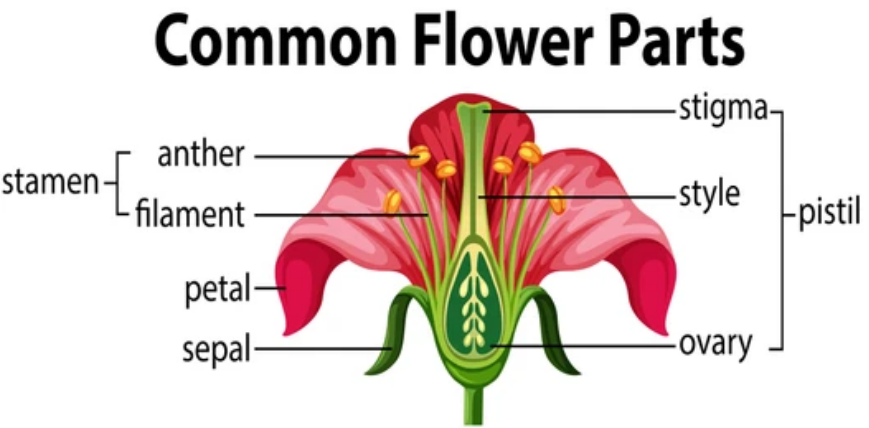
Which flowers are best for dissection?
Answer
407.4k+ views
Hint: The dismemberment of a deceased animal or plant's body to examine its anatomical structure is known as dissection (from Latin dissecare "to cut to pieces"; also known as anatomization). In pathology and forensic medicine, autopsy is done to ascertain the cause of death in humans. Medical students often perform less intensive dissections of plants and smaller animals preserved in a formaldehyde solution, whereas adults and children's cadavers, both fresh and preserved, are dissected extensively.
Complete answer:
Flowers can be dissected to determine the sections that are necessary for pollination and, as a result, reproduction of blooming plants. With the use of magnifying glasses, flowers can be inspected. To inspect the flower, carefully separate and cut out each portion with tweezers or scissors. Tulips, lilies, gladiolus, Alstroemerias, Hibiscus, and other flowers are ideal for dissection. Roses, daisies, iris, and other flowers with a difficult floral structure should be avoided.
Cross section of a flower-
The sepals (usually green), petals (usually colourful), stamens (male parts), and pistils are the four primary elements of a flower (female parts).
Petals use colours, smells, heat, and various patterns visible under ultraviolet and visible light to attract pollinators to the flower. The developing blooms are surrounded by sepals, which protect them. The pollinator will look for nectar inside the blossom once it has landed on it.
Pollinators rub up against the stamens (male parts) as they forage for nectar, and pollen adheres to their bodies. Later, as pollinators move to other flowers, some pollen will likely settle on the top of a pistil and journey downhill to fertilise the ovules (eggs) at the bottom of the pistil. After fertilisation, the ovules will grow into seeds.

Note:
Importance of dissection-
Assists kids in learning about interior structures of a specimen.
Students will be able to understand how the tissues and organs are connected.
In a hands-on learning setting, students gain an understanding of the intricacy of organisms.
In a school biology course, this is one of the most memorable and instructional units.
Complete answer:
Flowers can be dissected to determine the sections that are necessary for pollination and, as a result, reproduction of blooming plants. With the use of magnifying glasses, flowers can be inspected. To inspect the flower, carefully separate and cut out each portion with tweezers or scissors. Tulips, lilies, gladiolus, Alstroemerias, Hibiscus, and other flowers are ideal for dissection. Roses, daisies, iris, and other flowers with a difficult floral structure should be avoided.
Cross section of a flower-
The sepals (usually green), petals (usually colourful), stamens (male parts), and pistils are the four primary elements of a flower (female parts).
Petals use colours, smells, heat, and various patterns visible under ultraviolet and visible light to attract pollinators to the flower. The developing blooms are surrounded by sepals, which protect them. The pollinator will look for nectar inside the blossom once it has landed on it.
Pollinators rub up against the stamens (male parts) as they forage for nectar, and pollen adheres to their bodies. Later, as pollinators move to other flowers, some pollen will likely settle on the top of a pistil and journey downhill to fertilise the ovules (eggs) at the bottom of the pistil. After fertilisation, the ovules will grow into seeds.

Note:
Importance of dissection-
Assists kids in learning about interior structures of a specimen.
Students will be able to understand how the tissues and organs are connected.
In a hands-on learning setting, students gain an understanding of the intricacy of organisms.
In a school biology course, this is one of the most memorable and instructional units.
Recently Updated Pages
Master Class 11 Economics: Engaging Questions & Answers for Success

Master Class 11 Business Studies: Engaging Questions & Answers for Success

Master Class 11 Accountancy: Engaging Questions & Answers for Success

Master Class 11 English: Engaging Questions & Answers for Success

Master Class 11 Computer Science: Engaging Questions & Answers for Success

Master Class 11 Maths: Engaging Questions & Answers for Success

Trending doubts
Which one is a true fish A Jellyfish B Starfish C Dogfish class 11 biology CBSE

State and prove Bernoullis theorem class 11 physics CBSE

1 ton equals to A 100 kg B 1000 kg C 10 kg D 10000 class 11 physics CBSE

In which part of the body the blood is purified oxygenation class 11 biology CBSE

One Metric ton is equal to kg A 10000 B 1000 C 100 class 11 physics CBSE

Difference Between Prokaryotic Cells and Eukaryotic Cells




